By doing playful paintings, we learn how the paint moves across the paper and to expect the unexpected. We also learn how to control the accidents and help them work for us. Relax, don't force the paint; if we're uptight and work too hard, our work will come across stiff and contrived.
Tuesday, January 3, 2012
Don't Forget to Play
Watercolor is a wonderful medium for giving the artist gifts; they've often been called "divine accidents". Taking advantage of these gifts adds magical energy to a painting. We learn to see and use these unexpected wonders by playing with paints. Not every painting needs to be a masterpiece: don't take yourself too seriously. Take time to play with paint, take risks, and push limits just to see what will happen -- this can be reason enough to paint. Watch and observe and tap into your creative process.
Friday, December 2, 2011
Building a Bridge
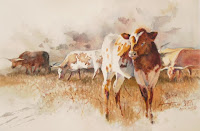 When painting realism, I believe that we should paint subjects as our eyes actually see them, not as a camera's lens captures them. Cameras are not selective in their focus and will put everything in the focal depth into sharp detail. A painting handled this way, while technically accurate, will lack emphasis and appear busy.
When painting realism, I believe that we should paint subjects as our eyes actually see them, not as a camera's lens captures them. Cameras are not selective in their focus and will put everything in the focal depth into sharp detail. A painting handled this way, while technically accurate, will lack emphasis and appear busy.Here's a way I've learned to correct this. Pick an object and stare at it without letting your gaze wander. Notice and remember how you see the neighboring objects. While we recognize what they are, they're less definite in their focus. This is how we should be painting. The center of interest should be in focus while the remaining objects are not.
I like to think of painting this way as building a bridge between the painting's borders and its center of interest, wherever that may be. I go for a steady transition from soft to high focus. Think of gradually sliding from low focus to sharp detail. A viewer should not perceive the change taking place. In my watercolor of long-horn cattle, I've used this concept to put the calf in focus and make it the center of interest. Best regards - Tom
Tuesday, October 4, 2011
Dillman's
The White Sand Lake in the forests of northern Wisconsin was my home for the past week. I was teaching a watercolor workshop for Dillman's Creative Arts Foundation. Located on a peninsula overlooking the lake, Dillman's has a rustic look, inside however, all of the buildings are modern and comfortable. The teaching rooms are large and well equipped. Sue and Denny Robertson plus their daughter, Stephanie, and son-in-law, Todd, were my hosts. They were gracious and very attentive to my needs and those of my students and made my stay a pleasure.
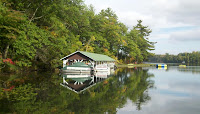



Late September is peak time in northern Wisconsin for autumn foliage: birches, assorted maples, and oak are juxtaposed against dark evergreens. The waters of the lake reflect these colors. And, yes, we had time and opportunity for pleine air painting. It was a magical time to be in those woods and I'll be back next year (the week of September 16-20, 2012). Look for me there!
Tom
Thursday, June 30, 2011
Finding One's Voice
A great deal of importance is placed on finding your voice or developing your style and mostly I think, "Rightly so!". Originality carries a lot of weight. Yet, I also believe that we can work too hard on developing a "look". I prefer to just let it happen by virtue of making personal choices like color selection, favorite shapes and patterns, tonal choices, brush strokes, content matter and so on.
Trying too hard can make work seem contrived or formulaic. On the other hand, if a body of work lacks cohesion, it may also be criticized. Damned if you do and damned if you don't. But it's interesting to look back on the work of great artists and see how often they changed their style or media. I'd recommend Picasso as a good example of this.
Trying too hard can make work seem contrived or formulaic. On the other hand, if a body of work lacks cohesion, it may also be criticized. Damned if you do and damned if you don't. But it's interesting to look back on the work of great artists and see how often they changed their style or media. I'd recommend Picasso as a good example of this.
Sunday, June 5, 2011
Creating Space Using "Push Back"
So often in painting we have a situation in which there are several objects that are very close in tone and color and we wish to create a sense of space in a subtle way. Using a technique called the "push back" is a good solution.
If you have a painting that doesn't read the right way spatially, decide which objects in the painting need to be closer. Next, paint a halo of very pale cobalt blue (very watered down) around the closest object and blend the halo as it moves away from that object and across the rest of the painting. This subtle temperature change pushes the other objects back creating an illusion of space.
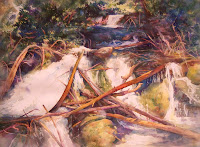
In my painting of Spruce Creek, I wanted to bring the windfalls on top to appear closer than the others and used this effect to push the rest back. These temperature changes are very important to create a sense of dimension and space in 2-D work. This glazing technique can be used in paintings of any subject from figurative to landscape. Give it a try!
If you have a painting that doesn't read the right way spatially, decide which objects in the painting need to be closer. Next, paint a halo of very pale cobalt blue (very watered down) around the closest object and blend the halo as it moves away from that object and across the rest of the painting. This subtle temperature change pushes the other objects back creating an illusion of space.

In my painting of Spruce Creek, I wanted to bring the windfalls on top to appear closer than the others and used this effect to push the rest back. These temperature changes are very important to create a sense of dimension and space in 2-D work. This glazing technique can be used in paintings of any subject from figurative to landscape. Give it a try!
Thursday, April 28, 2011
Variation on a Theme - Kolob Canyon
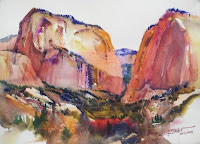
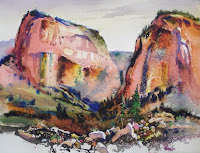
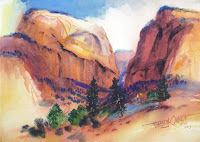
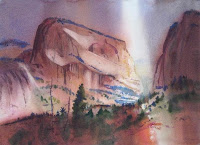
These watercolors are a series of class demos based on southwestern Utah"s Kolob Canyon. Doing a series is always a great way to explore possibilities. These paintings used a variation of technique and value plans. Methods include watercolor and ink, masking, wet-in-wet, watercolor impasto, lifting and glazing.
My Spring 2011 newletter is posted on my website -
http://www.thomasjowen.com/news.html
It's Part 1 or a 2 part series about painting light and shadow. Enjoy!
http://www.thomasjowen.com/news.html
It's Part 1 or a 2 part series about painting light and shadow. Enjoy!
Thursday, March 24, 2011
The Art of the Ordinary
The dilemma of what to paint. Over the years I've wondered about it and faced it by looking for strong subjects everywhere I go. These subjects are around us all the time and it's a good exercise to find and paint them. I like to walk around with a small digital camera and point it in the direction of anything interesting. Later, I go through the images to see what grabs my attention.
Often I'll make paintings from compositions of several photos. Moving subjects around until I get a dynamic design is one of my goals. If your painting is only as good as your reference material, you may miss a feeling you want to convey. I let the reference be a spring-board from which I develop my ideas.
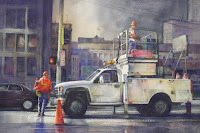
Often I'll make paintings from compositions of several photos. Moving subjects around until I get a dynamic design is one of my goals. If your painting is only as good as your reference material, you may miss a feeling you want to convey. I let the reference be a spring-board from which I develop my ideas.

In this painting of a city maintenance crew, the men are working to repair stop lights after a storm. I let the reflections on the wet street as well as the rich warm colors against the grey backdrop tell the story. With a value plan of a large light with small darks in a field of midtones, the eye is drawn to the focal point of the worker carrying a cone and then around the painting.
Labels:
dynamic design,
subjects,
value plan,
watercolor painting
Subscribe to:
Comments (Atom)


